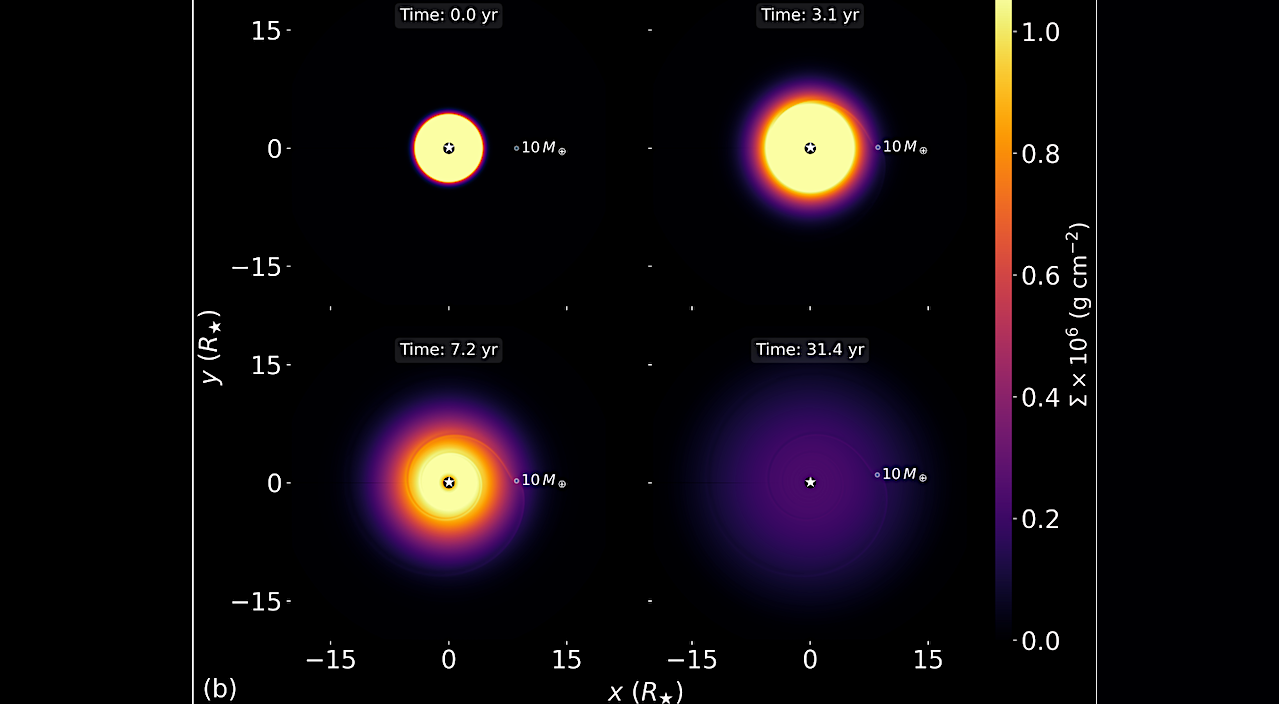Time evolution of the gas disk and planetary envelopes after the tidal disruption of a Jupiter-like planet. – Disc surface density evolution for the 10 M⊕ case; circles indicate the closer VEP. — astro-ph.EP
Context: Tidal disruption and engulfment events around main-sequence stars, such as the luminous red nova ZTF SLRN-2020 (a candidate planetary-engulfment event), reveal the destruction of close-in giant planets. While current observations focus on stellar accretion and inner dust emission, the fate of the volatile-rich material expelled during disruption remains poorly understood.
Aims: We investigate whether the H/He-rich gas expelled from the disrupted planet’s envelope and atmosphere can escape the inner system and be gravitationally captured by an outer low-mass planet (a volatile-enriched planet, or VEP), potentially forming a transient atmosphere and producing detectable volatile contamination.
Methods: We model the outward diffusion of gas from a tidally stripped giant using two-dimensional hydrodynamical simulations with FARGO3D, complemented by analytical estimates of volatile observability and atmospheric escape. We assess the efficiency of gas capture by outer planets and the survival timescales of the resulting secondary atmospheres under high-energy stellar irradiation.
Results: Our simulations show that volatile-rich gas can form a VEP. The resulting envelopes can contain between 1e-10 and 1e-6 Earth masses, up to the mass of Earth’s atmosphere, for Earth-like planets, yielding transit depths of tens to several hundred ppm. Such signatures may persist for 1 to 100 million years, depending on planetary mass, orbit, and stellar activity.
Conclusions: This scenario offers a viable pathway to form volatile-rich atmospheres in evolved low-mass planets. When accompanied by dynamical signatures such as eccentric orbits, these chemical anomalies may trace past planetary disruption. This framework may help interpret the atmospheric and orbital properties of systems like TOI-421b and WASP-107b, shedding new light on the late-stage evolution of planetary systems.
Mario Sucerquia, Matías Montesinos, Ana María Agudelo, Nicolás Cuello
Comments: Accepted for publication in Astronomy & Astrophysics. Comments welcome
Subjects: Earth and Planetary Astrophysics (astro-ph.EP)
Cite as: arXiv:2507.11693 [astro-ph.EP] (or arXiv:2507.11693v1 [astro-ph.EP] for this version)
https://doi.org/10.48550/arXiv.2507.11693
Focus to learn more
Submission history
From: Mario Sucerquia Dr
[v1] Tue, 15 Jul 2025 19:48:36 UTC (4,518 KB)
https://arxiv.org/abs/2507.11693
Astrobiology, Astrochemistry, Astrogeology,
